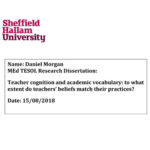The ELT Daily Journal: Learning to Teach ESL/EFL
Hall Houston, Anthimeria Press, 2013.
Reviewed by Brian Wadman
Mahidol University, Thailand
The ELT Journal by Hall Houston is an introductory journal/book designed for the novice language teacher just entering the field of English Language teaching. It is a comprehensive package of ideas, tips and resources. The premise of the book is built on the idea that a self-reflective teacher is a successful one. Of the 136 pages that make up the journal, 105 of the pages are blank, white-lined notebook pages for the new teacher to do their own critical self-reflection. Located at the bottom of each of the white-lined pages is a footnote of advice (in less than 50 words) under the categories: Icebreakers, Warmers, Closers, Classic Activities, Something to Ponder, Stop It! and Top Tips. At the completion of the journal pages are two additional sections; one chapter offers recommendations from 15 “legendary” experts in the field and the final section lists additional resources in the form of book suggestions, websites, periodicals, blogs and organizations for the new teacher to join.
Houston describes the goals of the journal as follows, “the book’s use is flexible; the pages contained here can be filled up in any of the following ways:
- Planning lessons
- Taking notes in a teacher training course (CELTA, TESOL, TKT, etc.)
- Keeping a diary during the beginning of your teaching career
- Jotting down sudden brainstorms
- Capturing thoughts and reflections while teaching overseas
- Highlighting important points that come up in a staff meeting
- Creating rough drafts of articles about teaching ESL/EFL” (p.IX)
To start off, the reader is introduced to veteran New Zealand professor Dr. Rose Senior. In less than four pages, Senior offers the pedagogical pathway to develop from a “newly-qualified, novice teacher to confident and competent language teaching professional”. She addresses four major problems the new teacher faces – pacing issues, timing issues, syllabus issues and communication issues. Senior then makes suggestions on how to improve the social climate of the classroom; including advising how to develop rapport with students and making classes more student-centered. A minor criticism of Senior’s introduction is the lack of any data to support the solutions she offers. To be fair, as the journal was written for the newly trained teacher, the simple, unempirical explanations she offers may be for their benefit.
One weakness of the journal is neither Houston nor Senior address the issue of which grammar to teach, standard or Lingua Franca English (LFE). Houston writes in one footnote “take a few notes of the most common or important errors you hear… you can mention the errors in a feedback session after the speaking activity ends. (p.9)” Houston leaves it up to the teacher to decide what constitutes an error. But in Lingua Franca English, more than one form can be seen as the standard. “We are now unable to treat English as a homogenous language characterized by a uniform norm or grammatical system… English is a heterogeneous language with multiple norms and diverse grammars (Canagarajah, 2006 p. 231, 232).
By failing to mention LFE, Houston could be directing novice teachers to reproduce a hegemonic norm of English whose usage is clearly dependent on context. As this review is being addressed to the Asian EFL Journal, an area of growing usage of LFE, the omission of this topic is significant. This is a difficult issue for the new teacher to confront, but one they must grapple with as they are developing habits which will be difficult to change if not attended to until later in their career.
Another criticism of the journal is that Houston only mentions the word culture twice in a book which is designed for teaching English as a second or foreign language. Culture which is part of the fabric of language plays a prominent role in second language acquisition. New teachers especially, need to make culture a fundamental consideration in their approach. In one footnote, Houston writes “find out more about students’ cultural background, skills and interests. Take a few minutes in each lesson to get your students to talk about themselves” (p.77). Culture and identity, as well as all of the knowledge students bring with them into the class, must be used as a bridges to transfer the learner into the acquisition of their new language. Are a few minutes really enough? Culture should have been mentioned more here.
Despite some of the book’s failings, this is a guide I would still recommend for the new teacher. Houston’s pedagogical approach of providing space for teachers to work out the issues by themselves is of sound value. As each situation is unique, there isn’t one approach that will work for all teachers. While The ELT Daily Journal only begins to unravel the complexity of teaching English as a second or foreign language, this is a guide I still wish I had possessed when getting started. It will help the new teacher towards a better understanding of the profession and allow them to more easily survive in their first year(s).
Reference:
Canagarajah, S. (2006). Changing communicative needs, revised assessment objectives: testing English as an International Language. Language Assessment Quarterly, 3(3), 229-242.
Author’s Bio Data:
Brian Wadman is a lecturer/visiting professor at Mahidol University’s Faculty of Liberal Arts. He graduated from the University of Massachusetts at Boston in Applied Linguistics in 2009. His research interests include critical pedagogy, virtual learning environments, and English as a Lingua Franca.








